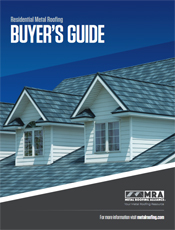MRA Offers Advice To Homeowners As Unpredictable Spring Weather Arrives

From early tropical storms to high winds and hail, rooftops often bear the brunt of severe spring weather. Image courtesy of MRA member Drexel Metals.
Portland, OR —With the official start of spring approaching, recent wild weather patterns have many U.S. and Canadian homeowners wondering what Mother Nature will usher in as the season draws closer. From blizzard conditions hitting many areas of
the country and crazy temperature fluctuations ranging from 80 degree-plus days to gale force winds and driving rain, current nationwide weather trends can be summed up in one word: unpredictable.
And if the past few years are any indication, homeowners would be well-advised to prepare for a roller coaster ride of highs and lows to continue for the next few months. That includes the potential for sudden
tornado strikes and costly hail and thunderstorm damage. High winds, ice and snow may suddenly give way to rapid thaws and heat.
And in hurricane-prone areas, it’s never too early to start preparing, as each year the season for severe tropical storms seems to strike earlier.
The one commonality wild spring weather events have is the fact that it’s the roof of a home that bears the brunt of them. Experts from the Metal Roofing Alliance (MRA) remind homeowners that it is their roof—above all else—that must be relied upon to protect a home from even more costly and serious damage during extreme weather.
To get prepared for spring season’s trifecta of threats, the MRA offers five tips for how to make sure your home’s roof can handle whatever Mother Nature has in store:
- Choose materials wisely
While many roofers believe quality metal roofing is the gold standard when it comes to protecting against extreme climate conditions, it’s important to keep in mind if your roof decking or sheathing isn’t structurally sound, the roofing materials
or upgrades you use won’t matter. Be sure to incorporate safeguards and accessories (such as hurricane clips and snow guards) that will help your home literally “baton down the hatches” in the event of extreme storms and guard against
damage.
- Don’t cut installation corners
How your roof is installed is just as important as the materials selected when it comes to long-lasting, durable protection. For example, when installed properly, metal roofs are rated to stand up to F2 tornado wind speeds (F-scale stands for the Fujita
Scale of Tornado Intensity, with F2 equaling wind speeds of 113-157 mph), resist leaks and are much less likely to puncture, tear or crack due to flying debris or massive hailstones. Be sure to ask your installer about proper insulation, venting and
underlayment designed to meet or exceed regional building codes for ongoing savings and protection.
- Use engineering and technology to your advantage
More and varied roof slopes can improve the aerodynamics of a structure and reduce the pressure on a roof caused by high winds. For new construction or major remodeling projects, work with your architect and engineer on ways to better control and reduce
the effects of strong wind force. Keep in mind that high tech metal roofing paint and coatings can make a huge difference for increasing protection and reliability while reducing energy costs over the long run.
- Go for style that delivers superior strength
Style practicality really shows when a roof is subjected to forces like hail. Even if they look intact, asphalt roofs are particularly prone to impact damage and can crack, dislodge and break, resulting in the need for premature replacement and increasing
the potential for costly interior damage. Quality metal roofs can withstand blows and remain intact even when subjected to the heaviest of hailstorms. Textured metal roof design patterns also may help disguise small dings and the minor cosmetic imperfections
resulting from hard-hitting impacts.
- Think security from top to bottom
Securing a roof to the walls decreases the potential of the roof flying off when it’s under intense pressure from high speed winds and severe air pressure fluctuations. During a tornado or hurricane, massive changes in air pressure caused by a penetration such as a broken window can blow a roof off.
Securely attaching a roof to the walls of your home helps prevent this phenomenon from occurring. Additionally, talk to your roofer about whether to consider installing a movable flap next to the seam of your roof, which also can help stabilize air
pressure.

“To help your home tame the beast that is extreme springtime weather, your best bet is to choose exterior materials and installation practices that promise resiliency, durability and long lasting protection,” said Renee Ramey, Metal Roofing
Alliance (MRA) executive director. “Doing so will pay off not just this season, but all year long and well into the future.”
For more tips and information, visit the MRA at www.metalroofing and download your
free copy of the Residential Metal Roofing Buyer’s Guide.
About The Metal Roofing Alliance
 Representing metal roofing manufacturers in the United States and Canada, the Metal Roofing Alliance (MRA) was formed in 1998 as a
nonprofit organization to help educate consumers about the many benefits of metal roofs. The main objective of MRA is to increase awareness of the beauty, durability and money-saving advantages of quality metal roofs among homeowners, as well as to
provide support for metal roofing businesses and contractors. For more information, visit
metalroofing.com.
Representing metal roofing manufacturers in the United States and Canada, the Metal Roofing Alliance (MRA) was formed in 1998 as a
nonprofit organization to help educate consumers about the many benefits of metal roofs. The main objective of MRA is to increase awareness of the beauty, durability and money-saving advantages of quality metal roofs among homeowners, as well as to
provide support for metal roofing businesses and contractors. For more information, visit
metalroofing.com.




